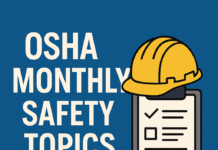
How To Become OSHA Safety Engineer 2024
In a world where workplace safety is paramount, the role of an OSHA Safety Engineer is more crucial than ever. These professionals play a vital role in ensuring that workplaces adhere to Occupational Safety and Health Administration (OSHA) regulations, creating an environment where employees can thrive without compromising their well-being.
I. Introduction
Ensuring workplace safety is not just a legal obligation but a moral one. Companies are increasingly recognizing the importance of having dedicated OSHA Safety Engineers on their teams. This article will guide you through the steps of becoming an OSHA Safety Engineer in 2024, shedding light on the qualifications, skills, and responsibilities associated with this rewarding career.
II. Understanding OSHA Regulations
Before delving into the specifics of becoming an OSHA Safety Engineer, it’s essential to have a solid understanding of OSHA regulations. These regulations are in place to safeguard the well-being of workers, outlining standards that businesses must adhere to. Compliance is not just a legal requirement; it’s a commitment to creating a safe and healthy work environment.
III. Qualifications and Education
To embark on a career as an OSHA Safety Engineer, a solid educational foundation is crucial. Most professionals in this field have a degree in occupational health and safety, engineering, or a related field. Additionally, there are specialized certifications and training programs that can enhance your qualifications and make you stand out in the job market.
IV. Skills Required
Beyond formal education, certain skills are instrumental in excelling as an OSHA Safety Engineer. Analytical skills are essential for assessing workplace risks, while effective communication skills are crucial for conveying safety protocols to diverse audiences. Attention to detail is another key skill, as identifying potential hazards requires a meticulous approach.
V. Job Responsibilities
The day-to-day responsibilities of an OSHA Safety Engineer are diverse. From inspecting workplaces for safety compliance to developing and implementing safety protocols, these professionals are the guardians of workplace well-being. Additionally, conducting training programs to educate employees on safety practices is a significant aspect of the role.
VI. Steps to Become an OSHA Safety Engineer
If you aspire to become an OSHA Safety Engineer, a systematic approach is key. Begin by pursuing relevant education in occupational health and safety or a related field. Gain practical experience through internships or entry-level positions, and consider obtaining certifications such as the Certified Safety Professional (CSP) designation.
Becoming an OSHA (Occupational Safety and Health Administration) safety engineer in 2024 requires a combination of education, experience, and certification. Here is a step-by-step guide on how to pursue this career:1. Educational Background:
- Obtain a Bachelor’s Degree: Earn a bachelor’s degree in a relevant field such as occupational safety, industrial hygiene, environmental health, or a related engineering discipline.
2. Gain Relevant Experience:
- Internships and Entry-Level Positions:
- Seek internships or entry-level positions in safety engineering, occupational health, or related fields to gain practical experience.
3. Specialized Training:
- OSHA Training Courses:
- Complete OSHA training courses to gain a deep understanding of OSHA regulations and standards.
- Certifications:
- Consider obtaining relevant certifications, such as the Certified Safety Professional (CSP) or the Associate Safety Professional (ASP) certification offered by the Board of Certified Safety Professionals (BCSP).
4. Advanced Education (Optional):
- Pursue a master’s degree in safety engineering, occupational safety, or a related field to enhance your knowledge and qualifications.
5. Networking:
- Attend industry conferences, workshops, and networking events to connect with professionals in the field.
- Join professional organizations related to safety engineering.
6. Stay Informed:
- Keep up-to-date with the latest developments in safety engineering, OSHA regulations, and industry trends.
7. Gain Professional Experience:
- Work in roles that allow you to accumulate hands-on experience in safety engineering, hazard analysis, risk assessment, and compliance.
8. Build Technical Skills:
- Develop technical skills related to safety engineering software, risk assessment tools, and other industry-specific technologies.
9. Continuing Education:
- Stay committed to continuous learning by participating in workshops, seminars, and online courses to stay informed about the evolving safety standards.
10. Prepare for Certification:
- If you haven’t already, prepare for and take relevant certification exams to enhance your professional credentials.
11. Apply for OSHA Safety Engineer Positions:
- Look for job opportunities with companies, government agencies, or consulting firms that require OSHA safety engineers.
12. Professional Growth:
- Once employed, seek opportunities for professional growth, take on challenging projects, and consider pursuing additional certifications or advanced degrees.
13. Maintain OSHA Compliance:
- Stay updated on OSHA regulations to ensure that you can effectively implement and maintain safety programs in your workplace.
14. Contribute to the Field:
- Share your knowledge and experience through articles, presentations, or involvement in industry associations.
15. Continuously Improve:
- As the field of safety engineering evolves, stay proactive in adapting to new technologies, methodologies, and regulations.
Remember, the journey to becoming an OSHA safety engineer requires a combination of education, practical experience, and ongoing professional development. Tailor your path based on your interests and the specific requirements of the industry you choose to work in.VII. Job Outlook
The demand for OSHA Safety Engineers is expected to grow in 2024 and beyond. As organizations prioritize employee safety, the need for qualified professionals in this field is on the rise. This section explores the promising career prospects and opportunities that await aspiring OSHA Safety Engineers.
VIII. Salary Expectations
While passion for workplace safety is a driving force, understanding the financial aspects of the career is also crucial. Explore the average salary for OSHA Safety Engineers and the factors that influence compensation in this field. This information will help you make informed decisions as you pursue this career path.
IX. Advantages of Being an OSHA Safety Engineer
Aside from the financial rewards, there are numerous intrinsic benefits to being an OSHA Safety Engineer. Contributing to workplace safety provides a sense of fulfillment and job satisfaction. This section delves into the various advantages of choosing this career, highlighting the positive impact these professionals can make.
X. Challenges in the Field
Like any profession, being an OSHA Safety Engineer comes with its set of challenges. Navigating non-compliance issues and addressing safety concerns in complex work environments can be demanding. This section prepares aspiring engineers for the challenges they may encounter and provides insights on overcoming them.
XI. Success Stories
Real-life success stories inspire and provide valuable insights. Hear from experienced OSHA Safety Engineers who have overcome obstacles and achieved success in their careers. Discover the lessons they’ve learned and gain practical tips that can guide you on your journey to becoming a successful engineer in this field.
XII. Networking and Professional Organizations
Building a network within the industry is instrumental for career growth. Explore the importance of networking and consider joining professional organizations related to occupational health and safety. These connections can open doors to opportunities and provide ongoing support throughout your career.
XIII. Continuous Learning
In a dynamic field like occupational health and safety, continuous learning is essential. Stay updated with industry trends, advancements in safety technologies, and changes in regulations. This section emphasizes the significance of ongoing education and provides resources for staying abreast of the latest developments.
XIV. Testimonials
What better way to understand the impact of being an OSHA Safety Engineer than through testimonials? Hear from professionals in the field and organizations that have benefited from their expertise. These firsthand accounts offer valuable insights into the tangible contributions of OSHA Safety Engineers.
XV. Conclusion
In conclusion, the journey to becoming an OSHA Safety Engineer is both challenging and rewarding. By following the outlined steps, gaining the necessary qualifications, and embracing the continuous learning aspect of the profession, aspiring engineers can contribute significantly to creating safer workplaces.
OSHA Fall Protection Plan Requirements
Occupational Health and Safety Administration (OSHA)
OSHA 500 Trainer Course: Fees, Eligibility, Duration, Syllabus, Exam, How To Apply
FAQs
- Is a degree in occupational health and safety mandatory to become an OSHA Safety Engineer?
- While not mandatory, a relevant degree enhances your qualifications and job prospects.
- What certifications are recommended for aspiring OSHA Safety Engineers?
- Certifications such as the Certified Safety Professional (CSP) designation are highly recommended.
- What challenges do OSHA Safety Engineers commonly face in their roles?
- Addressing non-compliance issues and navigating complex work environments are common challenges.
- How can networking benefit OSHA Safety Engineers in their careers?
- Networking provides opportunities for career growth, mentorship, and staying informed about industry trends.
- Are there ongoing educational opportunities for OSHA Safety Engineers to stay updated?
- Yes, continuous learning is crucial, and there are various resources and programs available for professionals in this field.





















